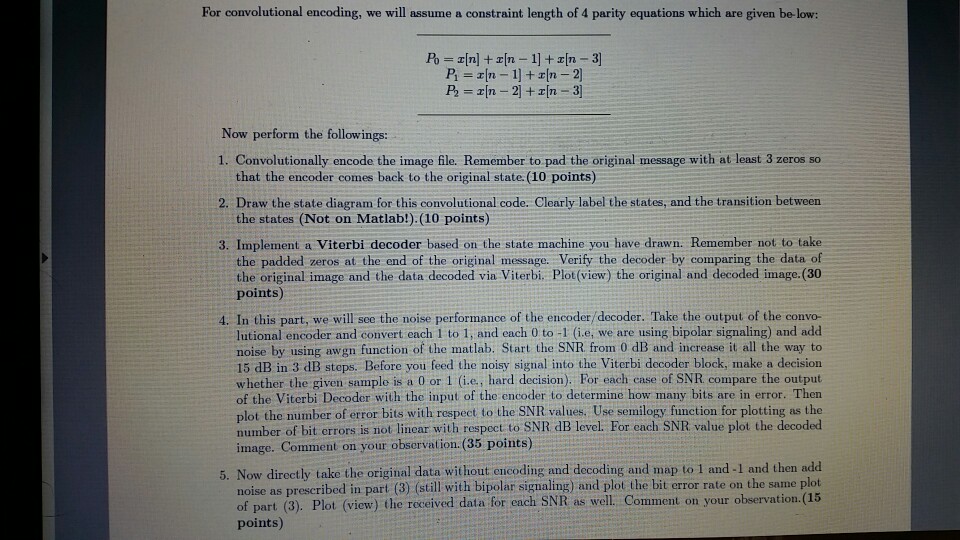Answered step by step
Verified Expert Solution
Question
1 Approved Answer
I NEED A HUUUUGE HELP For convolutional encoding, we will assume a constraint length of 4 parity equations which are given be-low: Now perform the

I NEED A HUUUUGE HELP
For convolutional encoding, we will assume a constraint length of 4 parity equations which are given be-low: Now perform the followings: 1. Convolutionally encode the image file. Remember to pad the original message with at least 3 zeros so 2. Draw the state diagram for this convolutional code. Clearly label the states, and the transition between 3. Implement a Viterbi decoder based on the state machine you have drawn. Remember not to take that the encoder comes back to the original state (10 points) the states (Not on Matlab!).(10 points) the padded zeros at the end of the original message. Verify the decoder by comparing the data of the original image and the data decoded via Viterbi. Plot(view) the original and decoded image. (30 points) 4. In this part, we will see the noise performance of the encoder/decoder. Take the output of the convo- lutional encoder and convert each 1 to 1, and each 0 to 1 (i.e, we are using bipolar signaling) and add noise by using awgn function of the matlab. Start the SNR from 0 dB and increase it all the way to 15 dB in 3 dB steps. Before you feed the noisy signal into the Viterbi decoder block, make a decision whether the given sample is a 0 or 1 (i.e., hard decision). For each case of SNR compare the output of the Viterbi Decoder with the input of the encoder to determine how many bits are in error. Then plot the number of error bits with respect to the SNR values. Use semilogy function for plotting as the number of bit errors is not linear with respect to SNR dB level: For each SNR value plot the decoded image. Comment on your observation. (35 points) 5. Now directly take the original data without encoding and decoding and map to 1 and -1 and then add noise as prescribed in part (3) (still with bipolar signaling) and plot the bit error rate on the same plot of part (3). Plot (view) the received data for ench SNR as well. Comment on your observation.(1 points) For convolutional encoding, we will assume a constraint length of 4 parity equations which are given be-low: Now perform the followings: 1. Convolutionally encode the image file. Remember to pad the original message with at least 3 zeros so 2. Draw the state diagram for this convolutional code. Clearly label the states, and the transition between 3. Implement a Viterbi decoder based on the state machine you have drawn. Remember not to take that the encoder comes back to the original state (10 points) the states (Not on Matlab!).(10 points) the padded zeros at the end of the original message. Verify the decoder by comparing the data of the original image and the data decoded via Viterbi. Plot(view) the original and decoded image. (30 points) 4. In this part, we will see the noise performance of the encoder/decoder. Take the output of the convo- lutional encoder and convert each 1 to 1, and each 0 to 1 (i.e, we are using bipolar signaling) and add noise by using awgn function of the matlab. Start the SNR from 0 dB and increase it all the way to 15 dB in 3 dB steps. Before you feed the noisy signal into the Viterbi decoder block, make a decision whether the given sample is a 0 or 1 (i.e., hard decision). For each case of SNR compare the output of the Viterbi Decoder with the input of the encoder to determine how many bits are in error. Then plot the number of error bits with respect to the SNR values. Use semilogy function for plotting as the number of bit errors is not linear with respect to SNR dB level: For each SNR value plot the decoded image. Comment on your observation. (35 points) 5. Now directly take the original data without encoding and decoding and map to 1 and -1 and then add noise as prescribed in part (3) (still with bipolar signaling) and plot the bit error rate on the same plot of part (3). Plot (view) the received data for ench SNR as well. Comment on your observation.(1 points)Step by Step Solution
There are 3 Steps involved in it
Step: 1

Get Instant Access to Expert-Tailored Solutions
See step-by-step solutions with expert insights and AI powered tools for academic success
Step: 2

Step: 3

Ace Your Homework with AI
Get the answers you need in no time with our AI-driven, step-by-step assistance
Get Started


